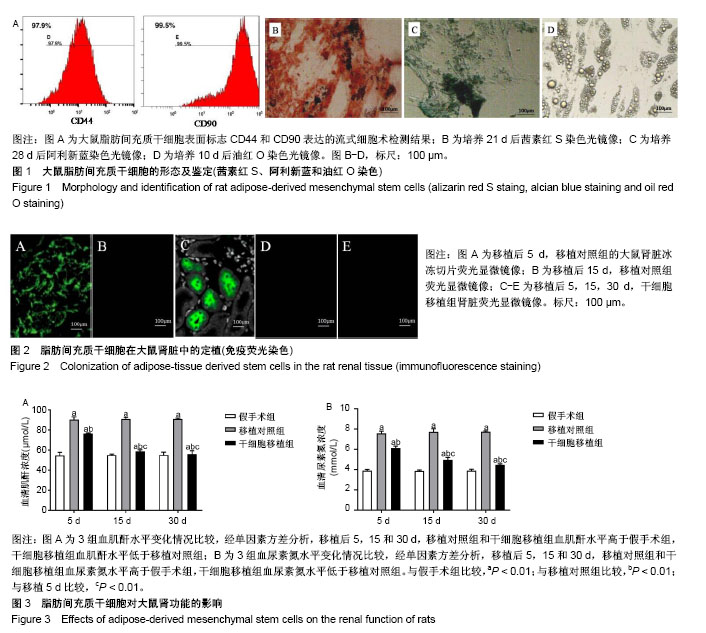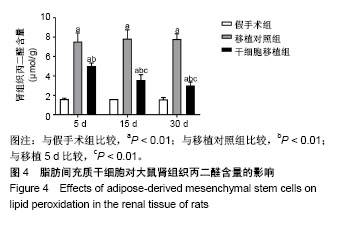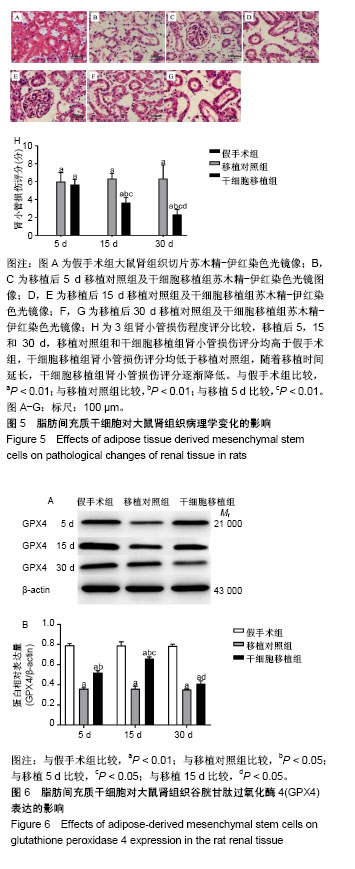| [1] Yu SQ, Ma S, Wang DH. Activation of TRPV1 prevents salt-induced kidney damage and hypertension after renal ischemia-reperfusion injury in rats. Blood Press Res. 2018;43(4):1285-1296.[2] Barakat M, Gabr MM, Zhran F, et al. Upregulation of heme oxygenase 1 (HO-1) attenuates kidney damage, oxidative stress and inflammatory reaction during renal ischemia/ reperfusion injury. Gen Physiol Biophys. 2018.37(2):193-204.[3] Wang W, Wang A, Luo G, et al. S1P1 receptor inhibits kidney epithelial mesenchymal transition triggered by ischemia/reperfusion injury via the PI3K/Akt pathway. Acta Biochim Biophys Sin (Shanghai). 2018; 50(7): 651-657.[4] Cruces P, Lillo P, Salas C, et al. Renal decapsulation prevents intrinsic renal compartment syndrome in ischemia-reperfusion-induced acute kidney injury: a physiologic approach. Crit Care Med. 2018;46(2): 216-222.[5] He Z, Tang H, You X, et al. BAPTA-AM Nanoparticle for the curing of acute kidney injury induced by ischemia/reperfusion. J Biomed Nanotechnol. 2018;14(5):868-883.[6] Ohtake T, Kobayashi S, Slavin S, et al. Human peripheral blood mononuclear cells incubated in vasculogenic conditioning medium dramatically improve ischemia/reperfusion acute kidney injury in mice. Cell Transplant. 2018;27(3):520-530.[7] Kim JS, Jang HJ, Jeong EK, et al. Crepidiastrum denticulatum extract ameliorates kidney ischemia-reperfusion injury in mice. Transplant Proc. 2018;50(4):1160-1166.[8] Choi YJ, Zhou D, Barbosa ACS, et al. Activation of constitutive androstane receptor ameliorates renal ischemia-reperfusion-induced kidney and liver injury. Mol Pharmacol. 2018;93(3):239-250.[9] Sheashaa H, Lotfy A, Elhusseini F, et al. Protective effect of adipose-derived mesenchymal stem cells against acute kidney injury induced by ischemia-reperfusion in Sprague-Dawley rats. Exp Ther Med. 2016;11(5):1573-1580.[10] Li B, Cohen A, Hudson TE, et al. Mobilized human hematopoietic stem/progenitor cells promote kidney repair after ischemia/reperfusion injury. Circulation. 2010;121(20):2211-2220.[11] Lin KC, Yip HK, Shao PL, et al. Combination of adipose-derived mesenchymal stem cells (ADMSC) and ADMSC-derived exosomes for protecting kidney from acute ischemia-reperfusion injury. Int J Cardiol. 2016;23(216):173-185.[12] Xing L, Cui R, Peng L, et al. Mesenchymal stem cells, not conditioned medium, contribute to kidney repair after ischemia-reperfusion injury. Stem Cell Res Ther. 2014;5(4):1-12.[13] Wise AF, Williams TM, Kiewiet MB, et al. Human mesenchymal stem cells alter macrophage phenotype and promote regeneration via homing to the kidney following ischemia-reperfusion injury. Am J Physiol Renal Physiol. 2014;306(10):F1222-1235.[14] Ayatollahi M, Hesami Z, Jamshidzadeh A, et al. Antioxidant effects of bone marrow mesenchymal stem cell against carbon tetrachloride- induced oxidative damage in rat livers. Int J Organ Transplant Med. 2014;5(4):166-173.[15] Kim Y, Jo SH, Kim WH, et al. Antioxidant and anti-inflammatory effects of intravenously injected adipose derived mesenchymal stem cells in dogs with acute spinal cord injury. Stem Cell Res Ther. 2015;6(1):229.[16] Zhang JB, Wang XQ, Lu GL, et al. Adipose-derived mesenchymal stem cells therapy for acute kidney injury induced by ischemia-reperfusion in a rat model. Clin Exp Pharmacol Physiol. 2017;44(12):1232-1240.[17] 侯晓琳,郁卫东,崔梅花,等.小鼠脂肪间充质干细胞的分离培养及肠道归巢[J].中国组织工程研究,2015,19(6):854-860.[18] 周丽娜,王玉新,方林,等.内皮祖细胞修复缺血再灌注大鼠肾损伤[J].中国组织工程研究,2014,18(32):5146-5151.[19] Sung PH, Chiang HJ, Wallace CG, et al. Exendin-4-assisted adipose derived mesenchymal stem cell therapy protects renal function against co-existing acute kidney ischemia-reperfusion injury and severe sepsis syndrome in rat. Am J Transl Res. 2017;9(7):3167-3183.[20] 胡红林,王共先,邹丛,等.骨髓间充质干细胞治疗肾缺血再灌注损伤的旁分泌机制[J].中国组织工程研究与临床康复,2011,15(32):5995-5998.[21] Zou X, Jiang K, Puranik AS, et al. Targeting murine mesenchymal stem cells to kidney injury molecule-1 improves their therapeutic efficacy in chronic ischemic kidney injury. Stem Cells Transl Med. 2018;7(5): 394-403.[22] Guo Q, Wang J. Effect of combination of vitamin E and umbilical cord-derived mesenchymal stem cells on inflammation in mice with acute kidney injury. Immunopharmacol Immunotoxicol. 2018;40(2):168-172.[23] Lee SJ, Ryu MO, Seo MS, et al. Mesenchymal stem cells contribute to improvement of renal function in a canine kidney injury model. In Vivo. 2017;31(6):1115-1124.[24] Tian SF, Jiang ZZ, Liu YM, et al. Human urine-derived stem cells contribute to the repair of ischemic acute kidney injury in rats. Mol Med Rep. 2017;16(4):5541-5548.[25] Jiang Y, Jahagirdar BN, Reinhardt RL, et al. Pluripotency of mesenchymal stem cells derived from adult marrow. Nature. 2002;418(6893):41-49.[26] Pavyde E, Usas A, Maciulaitis R. Regenerative pharmacology for the treatment of acute kidney injury: skeletal muscle stem/progenitor cells for renal regeneration? Pharmacol Res. 2016;113(Pt B):802-807.[27] Fateme Zhaleh, Fatemeh Amiri, Mohammad Mohammadzadeh-Vardin, et al. Nuclear factor erythroid-2 related factor 2 overexpressed mesenchymal stem cells transplantation, improves renal function, decreases injuries markers and increases repair markers in glycerol-induced Acute kidney injury rats. 2016;19(3):323-329.[28] Kuppe C, Kramann R. Role of mesenchymal stem cells in kidney injury and fibrosis. Curr Opin Nephrol Hypertens. 2016;25(4):372-377.[29] Cóndor JM, Rodrigues CE, Sousa Moreira Rd, et al. Treatment with human wharton's jelly-derived mesenchymal stem cells attenuates sepsis-induced kidney injury, liver injury, and endothelial dysfunction. Stem Cells Transl Med. 2016;5(8):1048-1057.[30] Elhusseini FM, Saad MA, Anber N, et al. Long term study of protective mechanisms of human adipose derived mesenchymal stem cells on cisplatin induced kidney injury in sprague-dawley rats. Regen Med. 2016;12(1):36-48.[31] Murata S, Sugiyama N, Maemura K, et al. Quantified kidney echogenicity in mice with renal ischemia reperfusion injury: evaluation as a noninvasive biomarker of acute kidney injury. Med Mol Morphol. 2017; 50(3):161-169.[32] Si XY, Li JJ, Yao T, et al. Transforming growth factor-β1 in the microenvironment of ischemia reperfusion-injured kidney enhances the chemotaxis of mesenchymal stem cells to stromal cell-derived factor-1 through upregulation of surface chemokine (C-X-C motif) receptor 4. Mol Med Rep. 2014;9(5):1794-1798.[33] Semedo P, Wang PM, Andreucci TH, et al. Mesenchymal stem cells ameliorate tissue damages triggered by renal ischemia and reperfusion injury. Transplant Proc. 2007;39(2):421-423.[34] Monteiro MB, Patente TA, Mohammedi K, et al. Sex-specific associations of variants in regulatory regions of NADPH oxidase-2 (CYBB) and glutathione peroxidase 4 (GPX4) genes with kidney disease in type 1 diabetes. Free Radic Res. 2013;47(10):804-810. |
.jpg)



.jpg)